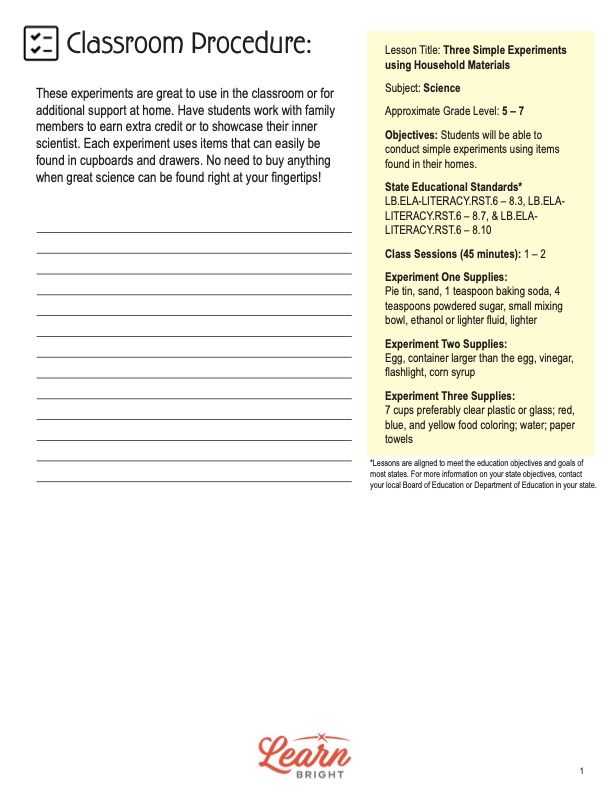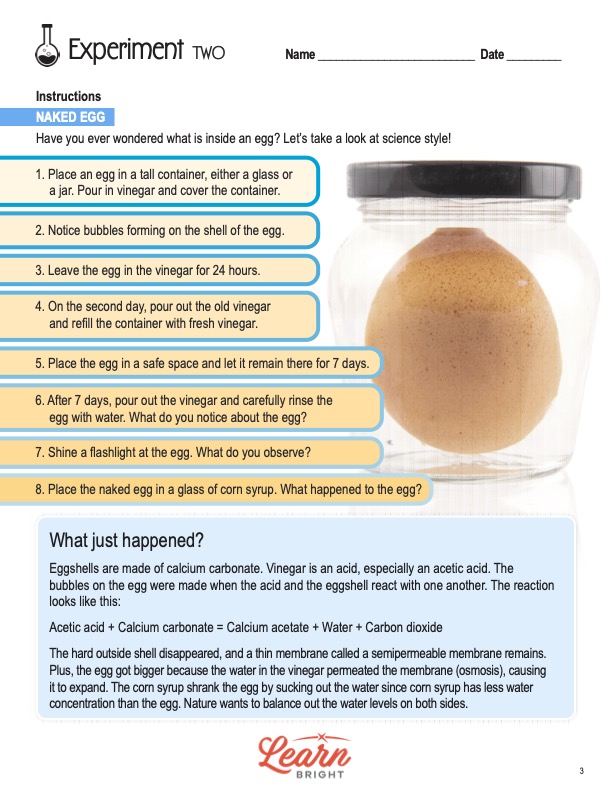Description
What our Experiments with Household Materials STEM lesson plan includes
Lesson Objectives and Overview: Experiments with Household Materials STEM provides a fun opportunity for students to use regular household items in scientific experiments. Students will conduct three experiments throughout the lesson using different items they would easily find in their homes. This lesson is for students in 5th grade and 6th grade.
Classroom Procedure
Every lesson plan provides you with a classroom procedure page that outlines a step-by-step guide to follow. You do not have to follow the guide exactly. The guide helps you organize the lesson and details when to hand out worksheets. It also lists information in the yellow box that you might find useful. You will find the lesson objectives, state standards, and number of class sessions the lesson should take to complete in this area. In addition, it describes the supplies you will need as well as what and how you need to prepare beforehand. Experiment one requires pie tins, sand, baking soda, powdered sugar, mixing bowls, lighter fluid or ethanol, and a lighter. For experiment two, you will need eggs, containers, vinegar, flashlights, and corn syrup. The final experiment requires clear plastic or glass cups, food coloring for the primary colors, water, and paper towels. You can choose to have students conduct one or two of these experiments at home under parental supervision.
EXPERIMENTS WITH HOUSEHOLD MATERIALS LESSON PLAN WORKSHEETS
The Experiments with Household Materials STEM lesson plan includes three experiment pages. Each one will help students demonstrate their knowledge and will reinforce concepts regarding conducting experiments safely.
EXPERIMENT ONE
The first experiment involves creating a sugar fire snake. Students will need to be very careful as they conduct this test because it involves fire. Make sure all students have a bucket or glass of water nearby just in case of emergency. You will also need to make sure they conduct the experiment in a well ventilated area and use a fireproof base.
First, students will combine powdered sugar with baking soda in the bowl. Then they will fill a pie tin or other non-flammable base with sand. They will next make a small mound in the middle of the dish and create an indent with their thumb.
The third step is to pour ethanol both into the indent and around the mound and ensure they soak up the sand. On the center of the mound, they will pour the sugar and baking soda mixture. The final step requires you as the adult to light the sand next to the sugar mixture. The mixture will start to bubble and turn black. Soon, a snake will form and grow.
At the bottom of the first experiment page, students can read a short paragraph that describes what happened and why. They will discover that three different chemical reactions occurred because of the heat from the fire. The sugar burns and pushes the mixture up. Some of the sugar doesn’t get oxygen and undergoes thermal decomposition, producing a solid carbon (the snake). The baking soda and heat create sodium carbonate and other chemicals. All three reactions create the body, shape, and color of the snake.
EXPERIMENT TWO
For the second experiment, students will discover what’s inside an egg “science style.” First, they will place an egg in a tall container, either a glass or jar. They will pour in vinegar and cover the container. Bubbles will start to form on the egg’s shell. Students will leave their eggs in the jars of vinegar for 24 hours.
On the second day, students will pour out the old vinegar and then refill the containers with fresh vinegar. Then they will place the egg in a safe place and leave it alone for seven days. After that week, they will again pour out the vinegar and carefully rinse the egg with water. At this point, they should think about what they notice about the egg.
The next step is to shine a flashlight at the egg and observe what happens. Finally, they will place it in a glass of corn syrup and again see what happens. Similar to the first experiment, the worksheet provides an explanation that explains what occurred.
Because eggshells consist of calcium carbonate, the presence of vinegar (which is an acetic acid) will produce a chemical reaction. The result is calcium acetate, water, and carbon dioxide. As a result, the hard shell disappears, and a thin membrane remains. Water and vinegar permeates the membrane through osmosis causing the egg to grow bigger. The corn syrup shrinks the egg by sucking out the water.
EXPERIMENT THREE
Students will get to watch water “walk” for the final experiment. Essentially, they will create a rainbow as water “walks” from one glass of water to another across a paper towel. First, they will put seven glasses on a counter. They will fill glasses 1, 3, 5, and 7 about three-quarters full of water. Next, they will add food coloring to four of the glasses according to the instructions on the worksheet.
Then students will fold a paper town in half long way (width-wise) repeatedly until it is about an inch wide. They will then fold the paper towel in half lengthwise once. It should look like a long flat piece folded into an arch shape. They will repeat this step six more times.
On the last step, students will place one side of the folded paper towel in glass 1 and the other in glass 2. Then they will place the next folded paper towel in glasses 2 and 3. They will repeat this pattern with the remaining paper towels and glasses.
Students will learn that this experiment demonstrated capillary action in motion. This is the process in which liquid moves up something solid. It happens when three different forces interact: cohesion, adhesion, and surface tension. Water molecules are cohesive, and they adhere to the paper towel. As each water molecule moves up the towel, it pulls another molecule with it all the way to the top and down again.
ADJUSTMENTS
If you prefer, you can have students conduct any number of these tests at home rather than in the classroom. You may also choose to have students work together on the tests so that you don’t need as many materials.








